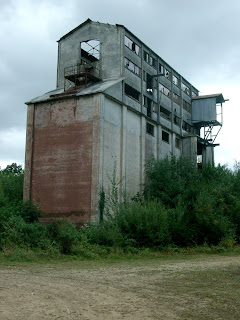Yesterday we enjoyed a warm sunny day - a good way to end August. While Rob walked around Bagnoles de l"Orne taking photos of the houses which were built in the late 19th century when the town became a spa resort.I walked through the wooded area there looking for bilberries. I found a few but I think it was just luck as the plants appeared to have been stripped of their fruits. At least there were plenty of healthy looking plants so next year I will get there earlier in the summer.
I have finally found some local history material in our local library. Alain Hairie, who family lived in Domfront has written a few small booklets about the second world war, in particular, how Jewish children were hidden and cared for by the local community and about the relgious community in Perrou - a nearby village- where the sisters ran an orphanage, old peoples home and cared for the sick. They also took in Jewish children and some of their mothers before the community was taken over by the Germans towards the end of the war and used it as a hospital to care for soldiers injured on the front. He has interviewed some of those who lived in the area and whose families were involved. He has also tracked down some of the children who were hidden. Of course the information they have given is very limited as all those interviewed were very young during the war and have limited memories of the events that happened around them. He has realised that he has undertaken this research rather late in the day and has missed the chance to interviiew those who were active both in the resistance and in the community.
One of his books covers some of the bombing of the area and reference is made to the 'flying fortresses' attempting to destroy the fuel depots which were hidden in the forests between Domfront and Bagnoles. Apparently there is still evidence of bomb caters to be seen in the woods, just like we have around us in Bury St Edmunds. See the link for more information http://www.ansa39-45.fr/independencedayenglish.htm
Last week we visited the village of La Gué Plat which was purpose built in the 1920's to house the mine workers of the iron ore mine which was opened there. There are still remnents of the mining activity to be seen, strangely set against the local forest landscape. We learned that iron ore mining has been taking place in the area for a very long time as there is a band of iron deposits which came to the surface in this village and the pits can still be seen where the ore was excavated.
We have since discoved that the Orne Valley south of Caen has been the most important source of iron ore in France and the reason that the canal was built from Caen to the see, to export the ore and import the coal needed for the furnesses.The garden continues to feed us well, and I am now planning next years vegetable garden. The ground has become rock hard due to the lack of rain, but I continue to water the beans and the butternut squash and hope to get a good harvest from them. There is a severe drought in a large number of departments, including the department of the Mayenne which is just a couple of kilometers south of here. There have water restictions and the television news shows the land dry as dust and crops such as the maize and sunflowers wilting in the fields. We noticed this when we went down to the Loire Valley a couple of weeks ago. The maize fields here are lush and the crop at least 2.5m high. As a local farmer said last week, we can sometimes be glad that we are in Normandy and get as much rain as we do.




No comments:
Post a Comment